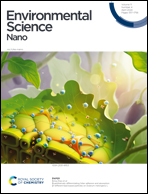Carbon nanotubes as a nanocatalyst and nanoreactor for the efficient treatment of pharmaceutical wastewater via CaSO3 activation†
Abstract
Recently, calcium sulfite (CaSO3) has been increasingly considered to be the most potential substitute for PMS/PDS to produce SO4·− for degrading target organic pollutants due to its fewer toxic side effects, lower cost, and absence of residues after decontamination. In this regard, herein, we report carbon nanotubes (CNTs) as an efficient catalyst and nanoreactor for activating CaSO3 for water decontamination. Compared with NaHSO3 and Na2SO3, the result exhibited that the order of tetracycline (TC) removal rate at 30 min as follow: CaSO3 (80.2%) > Na2SO3(49.3%) > NaHSO3 (48.8%). Because CaSO3 can slowly discharge SO32−, it could be used as a sustained-release SO32− source, which could effectively solve the quenching issue of SO4·− at a high concentration of SO32−. Control experiments confirmed the vital roles of electron transfer and dissolved O2 in the formation of SO3·− and SO4·− in the CNTs/CaSO3 system, as also verified by quenching experiments and EPR analysis. More importantly, we found that the CNTs/CaSO3 system had excellent potential for the treatment of actual pharmaceutical wastewater, with the total organic carbon and chemical oxygen demand dropping by 42% and 70% after treatment, respectively. In addition, germination experiments of wheat seeds confirmed that the biotoxicity of TC to wheat seeds was greatly reduced after treatment with the CNTs/CaSO3 system.

- This article is part of the themed collection: Environmental Remediation


 Please wait while we load your content...
Please wait while we load your content...